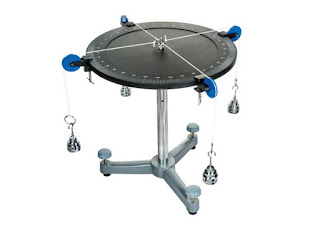PRACTICAL 9
To determine the resultant of two forces graphically using a Horizontal force table.VIVA VOCE
1. What is the objective of this practical experiment?
Ans: The objective is to determine the resultant of two forces graphically using a horizontal force table.
2. Describe the setup of a horizontal force table.
Ans: A horizontal force table consists of a circular platform with a center pin. Forces are applied to the platform using strings or ropes attached to pulleys at various angles.
3. How do you represent forces graphically on a force table?
Ans: Forces are represented by vectors, where the direction of the vector corresponds to the direction of the force, and the magnitude of the vector represents the magnitude of the force.
4. What is the principle behind determining the resultant of two forces graphically?
Ans: According to the parallelogram law of vector addition, the resultant of two forces is represented by the diagonal of the parallelogram formed by the vectors representing the individual forces.
5. How will you set up the forces on the force table?
Ans: Attach strings or ropes to the pulleys on the force table and adjust the angles to represent the given forces. Ensure the forces are accurately represented in both direction and magnitude.
6. What measurements will you take during the experiment?
Ans: Measure the angles of the strings from the horizontal axis and the tensions in the strings using a spring balance.
7. How will you determine the resultant graphically?
Ans: Draw the vectors representing the forces to scale on a piece of paper, then construct a parallelogram using these vectors. The diagonal of the parallelogram represents the resultant force.
8. What precautions will you take to ensure accuracy?
Ans: Ensure the force table is leveled, use calibrated equipment for measurements, and make sure the strings are taut and free from any slack.
9. Why is it important to represent forces graphically in some situations?
Ans: Graphical representation provides a visual understanding of the resultant of forces, which can be crucial in engineering, physics, and other fields where precise manipulation of forces is required.
10. Can you apply this method to determine more than two forces' resultant?
Ans: Yes, the same method can be extended to determine the resultant of multiple forces by adding additional vectors and constructing a polygon where the resultant is the closing side.
